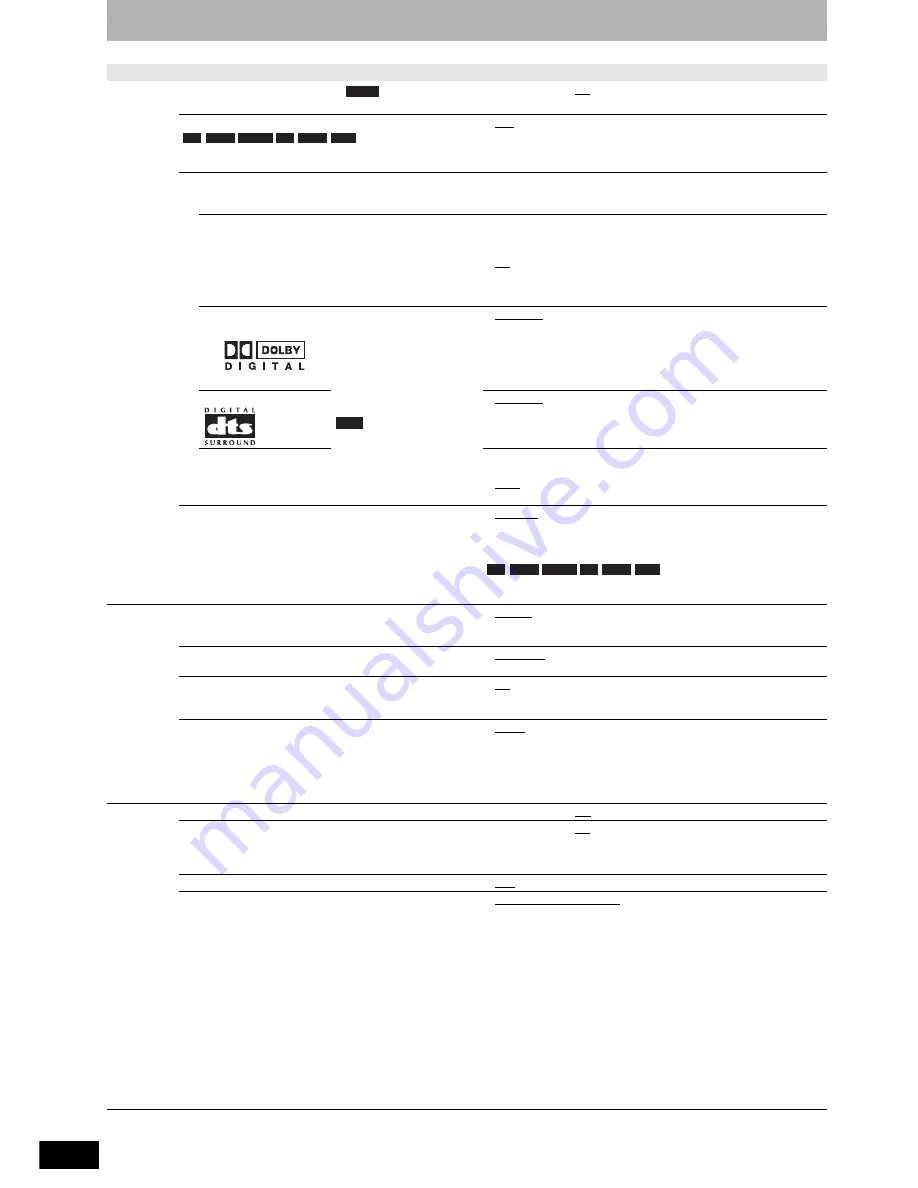
RQT8318
40
40
Changing the unit’s settings
Refer to the control reference on page 36.
Tabs
Menus
Options (Underlined items are the factory presets.)
Sound
Dynamic Range Compression
(Dolby Digital only)
Change the dynamic range for late night viewing.
• On
• Off
Bilingual Audio Selection
Select whether to record the main or secondary audio type
when recording to a disc.
• M 1
• M 2
You cannot select this when recording from an external source
(except from DV equipment connected to this unit’s DV IN terminal).
Select the audio on the other equipment.
Digital Audio Output
Change the settings when you have connected equipment through this unit’s DIGITAL AUDIO OUT terminal (
➔
page 10).
• Press [ENTER] to show the following settings.
PCM Down Conversion
Select how to output audio with a sampling frequency
of 96 kHz or 88.2 kHz.
• Signals are converted to 48 kHz or 44.1 kHz despite
the above settings if the signals have a sampling
frequency of over 96 kHz or 88.2 kHz, or the disc has
copy protection.
• On:
Signals are converted to 48 kHz or 44.1 kHz.
(Choose when the connected equipment cannot process
signals with a sampling frequency of 96 kHz or 88.2 kHz.)
• Off:
Signals are output as 96 kHz or 88.2 kHz.
(Choose when the connected equipment can process
signals with a sampling frequency of 96 kHz or 88.2 kHz.)
Dolby Digital
Select how to output the
signal.
Select “Bitstream” if the
connected equipment
decodes the signal.
Select “PCM” if this unit
decodes the signal and
output it as 2 channel.
Note
Not making the proper
settings may result in noise
or some trouble for digital
recording.
• Bitstream: When connecting to equipment displaying the Dolby
Digital logo.
• PCM:
When connecting to equipment not displaying the
Dolby Digital logo.
DTS
• Bitstream: When connecting to equipment displaying the DTS
logo.
• PCM:
When connecting to equipment not displaying the
DTS logo.
MPEG
• Bitstream: When connected to equipment with a built-in MPEG
decoder.
• PCM:
When connected to equipment without a built-in
MPEG decoder.
Audio Mode for DV Input
You can select the kind of audio when recording from the
unit’s DV IN terminal (
➔
page 34).
• Stereo 1:
Records audio (L1, R1).
• Stereo 2:
Records added audio such as narration (L2, R2)
subsequent to original recording.
• Mix:
Records both Stereo 1 and Stereo 2.
When recording bilingual broadcast to a disc, select the type of
audio in advance from “Bilingual Audio Selection” (
➔
above).
Display
Language
Choose the language for these menus and the on-screen
messages.
• English
• Deutsch
• Français
• Italiano
• Español
• Nederlands
On-Screen Messages
Choose whether to show status messages automatically.
• Automatic
• Off
Grey Background
Select “Off” if you do not want to have the unit show the
grey background when tuner reception is weak.
• On
• Off
FL Display
Changes the brightness of the unit’s display.
This setting is fixed with “Automatic” if you set “Power Save”
to “On” (
➔
page 41).
• Bright
• Dim
• Automatic: The display turns dark during play, and reappears
momentarily when you press a button. When the unit
is turned off, all displays disappear. While using this
mode, the standby power consumption can be
reduced.
Connection TV Aspect (
➔
page 11)
• 16:9
• 4:3
• Letterbox
Progressive (
➔
page 12)
This setting is fixed with “Off” if you set “AV1 Output” to
“RGB 1 ( without component )” or “RGB 2 ( without
component )”.
• On
• Off
TV System (
➔
page 43)
• PAL
• NTSC
AV1 Output
Select the output from the AV1 terminal.
Select “RGB 1 ( without component )” or “RGB 2 ( without
component )” for RGB output.
Select “Video ( with component )” or “S Video ( with
component )” for component output (progressive output).
Set according to the signal and terminal of the connected
TV.
When a decoder is connected, do not set to “RGB 1
( without component )”.
• Video ( with component ):
Select when a TV is connected that can receive a composite
signal.
• S Video ( with component ):
Select when a TV is connected that can receive an S Video
signal.
• RGB 1 ( without component ):
Select when you have connected a TV that can receive RGB
signals.
Select this mode so the TV automatically switches to display the
picture from the unit when you turn the unit on.
• RGB 2 ( without component ):
Select when you have connected a TV that can receive RGB
signals.
If you would like to switch to display the picture from the unit only
when playback or viewing menus, select this mode.
DVD-V
-R
-R DL -RW(V) +R +R DL +RW
-R
-R DL -RW(V) +R +R DL +RW
Summary of Contents for DIGA DMR-ES15
Page 53: ...MEMO 53 RQT8318 ...
















































